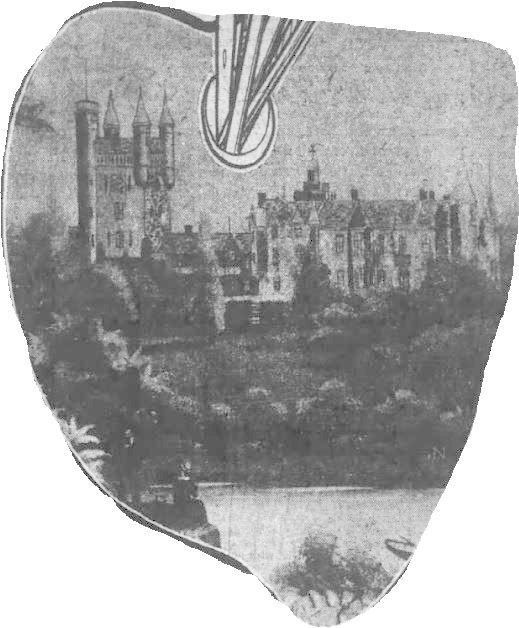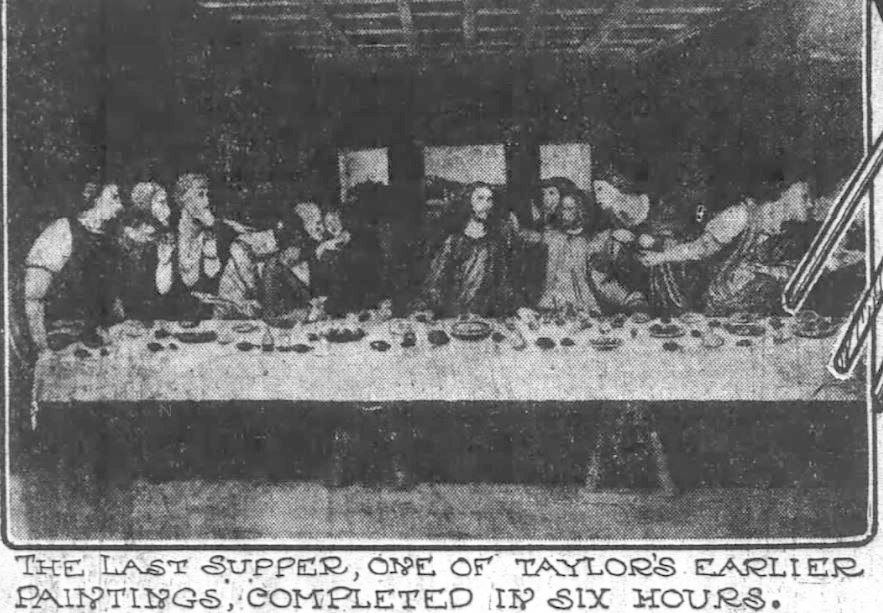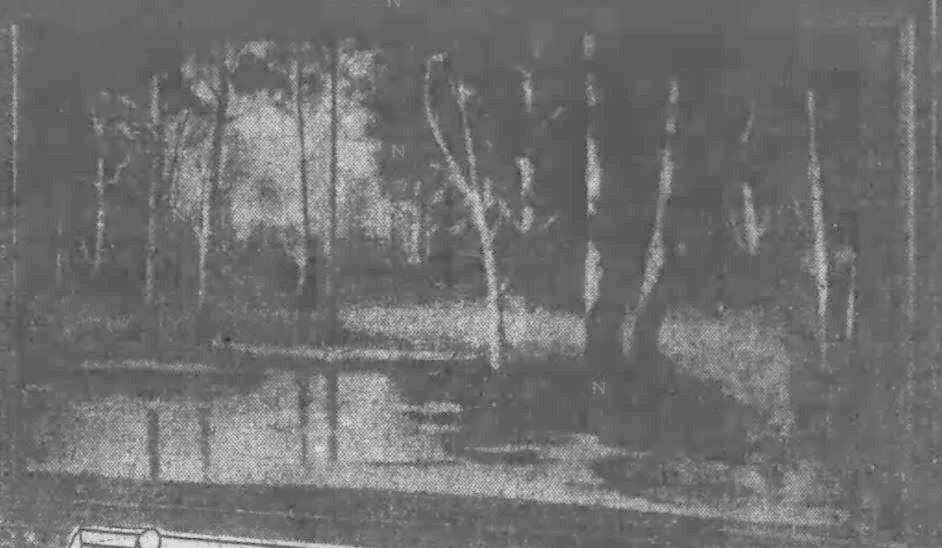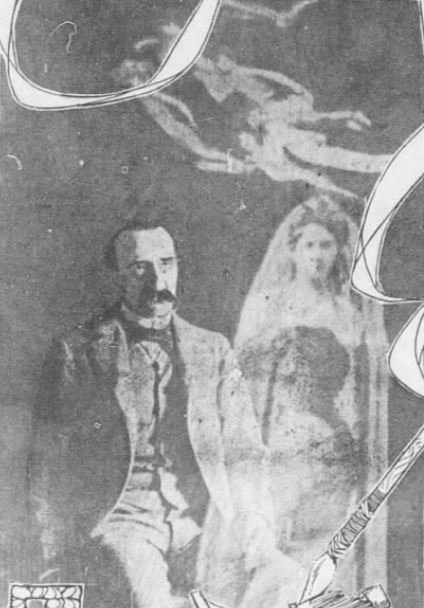Painting in the Dark with Raphael
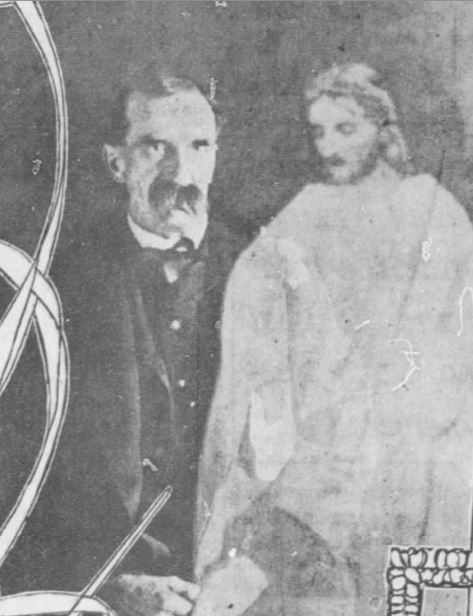
Painting in the Dark with Raphael Abel Taylor, psychic artist, who painted under Raphael’s influence in the dark.
Initially I thought that this story of an “automatic painter” who believed that he was controlled by the spirit of Raphael would be merely a minor footnote in the history of spiritualism. Spirit painters were not uncommon; their techniques have been extensively studied and analyzed. And yet, the story of how an ex-soldier suddenly took up his brushes at the age of 60 proved to have an uncanny aura about it with a story of mysterious visitants and mystical healing. Step into the gallery of Abel Taylor, disciple of the painter Raphael.
All followers, either open and avowed or secret and diffident, of Sir William Crookes, Sir Oliver Lodge, and other distinguished believers in spiritualism, the projection of the psychic personality or any of the supposed kindred occult phenomena, are flocking to the Soldiers’ Home, out Brightwood way, these days, to see a remarkable picture, which, according to the nominal artist, Abel Taylor, an inmate of the home, was painted at night and with no artificial light in his room. This claim in itself would not be of interest to the seekers of knowledge concerning the supernatural, but Taylor asserts that he is not responsible for the conception of the picture, and that he was only a blind instrument in the hands of his controlling spirit, and that spirit, he declares, with the utmost candor, is none other than the great Italian genius of the brush, Raphael.
And Taylor is not a dreamer. He impresses the visitor as being a very matter-of-fact, level-headed sort of individual. He does not claim any position of preeminence among his fellow-comrades; he does not try to shirk any responsibilities; he does not affect any of the idiosyncrasies of genius nor any of the whims of the clairvoyant. He is janitor of the Anderson Cottage at the home, and by all accounts a capable, painstaking caretaker. His story is interesting to the skeptic and the scoffer as well as to the believer, on account of the confidence which he undoubtedly has in his own supposed experiences.
Nor is the one picture which Taylor claims to have painted in the dark the only unique feature of his story. He professes never to have had a lesson in art, and never to have attempted to paint a picture until he was 60 years old. That was ten years ago, and since then 1,400 canvases have come from his brush and palette.
Life Story of Taylor.
This is the life story of Abel Taylor. Born in Dundee, Scotland, 70 years ago, he came to this country in 1869, and entering the United States army as a private, he served in Uncle Sam’s forces for 27 years. Leaving the service in 1898, being sufferer from chronic rheumatism, he became an inmate of the Soldiers’ Home, and was assigned to a room in Anderson cottage, where he still resides.
One evening in the fall of 1898, Taylor says that he was sitting in the guest chamber of the cottage, when his attention was attracted by seven forms, four women, two men, and a boy, standing outside the dwelling. They signaled to him to come outside. He hobbled to the door. When he arrived outside the figures disappeared around the corner of the cottage. Mystified at the queer actions, the rheumatic little man went back into the room and resumed his seat. The figures almost immediately appeared again and went through the same weird actions. Again he went outside, only to experience the same disappointment as before. This performance, he says, was repeated several times until nightfall, when it became too dark to see. With a feeling of uneasiness Taylor says, he then laboriously ascended the stairs to his bedroom and threw himself on his cot. His impression is that his room suddenly became brilliant lighted. Starting from the cot, to his surprise he saw the seven forms in his room. Each of the women appeared to have in her hand a wand-like instrument, which she began to wave slowly back and forth across his cot.
Suddenly he experienced a feeling as of electric currents passing through his body, following which he says his rheumatic pains were gradually eased.
All this time Taylor claims that he did not know whether the seven forms were flesh and blood or supernatural beings, for prior to this visitation he had never understood spiritualism, and had never attended a séance.
The next night Taylor says there was the same apparition, and he was given more treatment by the women with the wands. This time his fear had somewhat subsided and he submitted to the treatment gladly.
As he lay at ease with the women waving the wands gently back and forth, he began to study the faces of his spectral healers. In one he seemed suddenly to recognize his sister, who had been dead many years.
The following morning, Taylor’s rheumatism was so much better that he was able to walk about the grounds. His comrades marveled at the sudden change in his condition, and it became noised around the home and veterans came from all directions to question the little Scotchman.
At intervals during the day, Taylor claims, he would run across the different members of the spectral group. This occurred in the halls, the grounds, and in his own room. As the spirits would speak to him, and he would reply, the other old soldiers who happened to be standing by, but to whom the visitors were invisible, regarded him suspiciously as being “daffy” because he stood in the corridors talking to himself.
For thirteen nights and days the seven spirits were with the little Scotchman, and on the thirteenth day, the boy-spirit came up to him in the hallway, and pulling him by the garment, told him that “Joe” wanted to see him. Inquiring who “Joe” was, Taylor was cautioned by the boy to say nothing, but follow him. This he did, and was conducted to a room upstairs, where he met the spirit of a man, who, patting him on the head, exclaimed: “You poor, poor old soldier, be of good cheer; we have found work for you to do.”
Instructed to Paint.
With this both spirits disappeared, leaving Taylor bewildered. That night the seven spirits were in his room for the last time, and told him that this would be his final treatment. After this announcement had been made by the spirit “Joe,” the female specter whom he had recognized as the spirit of his sister, stepped forward and called him brother, and kissed him. After this she told him to go and paint pictures. Taylor replied that he had never had a paint brush in his hands.
His sister answered that his “control” would be the spirit of the famous artist, Raphael. She also gave him instructions to purchase all supplies necessary for the making of pictures. With this the ghostly crowd disappeared.
When Taylor awoke the next morning he discovered, to his great joy, that he was entirely free from all aches and pains, something he had not been rid of for more than twenty years. He remembered the command, and so he came into Washington and spent all his money for canvases, paint, brushes, and other accessories…
After Taylor had lugged his material to his room he erected a canvas on a home-made easel, which he still uses, and, placing his colors in a row, he picked up two brushes and awaited developments. He had not long to wait, for suddenly the brushes were swept from his hand into the most distant corner of the room With great patience the old soldier recovered his brushes, and once more sat down in front of the canvas. Again the brushes were torn from his hand and flung against the opposite wall.
Taylor began to get nervous, but with determination he picked up the brushes, and holding them as tightly as he could, he was startled to see a hand reach out and grasp his arm and little above the wrist. In another moment his hand was guided toward paint of a certain color. The hand was then guided toward the canvas.
No sooner was the brush placed against the canvas, Says Taylor, than he felt his arm grasped firmly, and the next moment he was daubing away at a great rate. As soon as he had gone far enough with one color another brush would be selected, as well as another color; and in this way he gradually saw forming itself on the canvas before him the picture of a stately castle set in a grove of trees, with a lake in front. At last the picture was completed, and then Taylor says he recognized it as a castle in North Wales, a place he had often visited when a boy. [To me it looks more like Scottish Baronial-style, which I don’t think is common in Wales.]
The first painting done by Abel Taylor under the influence of “Raphael” The newspaper printed it inside a palette vignette.
This picture, the first ever painted by Taylor, is now on exhibition in his private gallery out at the Soldiers’ Home. It is crude, very crude, and yet there are touches that one can hardly believe were made by a man who had never studied art.
Taylors’ best pictures, however, are those that deal with religious subjects. Some of the most enthusiastic believers in his story profess to see the style of Raphael. This is a question of individual judgment—or shall we say imagination?
Painting in the Dark with Raphael The Last Supper (obviously copied from Leonardo), completed in six hours.
In the 1,400 pictures which has completed, almost every sacred subject has been touched upon. There are numerous paintings of the crucifixion, of the descent from the cross, the last Supper, the betrayal, the return of the prodigal, the Celestial mansions, and Mary Magdalen. In the collection are to be seen also copies of Landseers, Rembrandts, Van Dykes, and other masters, but, of course, Raphael is the favorite. When questioned about these copies Taylor says he buys cheap prints of the pictures and takes them to his room. Sometimes his “control” will have these copied, sometimes not. He claims that the average time spent on one of his larger canvases is six hours—two hours a day for three days.
Painting in the Dark with Raphael Woodland Scene by Abel Taylor, painted entirely in the dark.
Many of his more recent pictures show considerable improvement over his earlier paintings, and one canvas in particular, a woodland scene, is noteworthy, owing to the really splendid effect of sunshine and shadow filtering through the branches of the trees. The canvas, which he asserts was painted in the dark, is a California woodland scene, with the giant trees towering high in air, casting in deep shadow the herd of deer grazing beneath the intertwined branches. Taylor says this is a reproduction of a post where he camped with his regiment twenty years ago, but that he did not know what he was painting until the canvas was completed.
Spiritualists will find in Taylor a splendid confirmation of their most pronounced views, while scientists and psychologists will see in him a remarkable example of a man laboring under the strongest of hallucinations.
In any case he is a unique personality and an interesting study. Quite willing to discuss with any one his supposed “power,” he does not endeavor to make converts to his theories. He says that his “control” has instructed him to speak freely, and without reserve to all asking for information, but not to attempt to argue as to the authenticity of his experiences. He does not take offense when the visitor scouts the idea of “spirit control,” and he does not go into ecstasies when a questioner professes faith in his story. Both viewpoints are, or seem to be, matters of indifference to him. He remains to both the credulous and the incredulous the obliging, deferential janitor of Anderson cottage, Soldiers’ Home. His announced “supernatural power” is a thing entirely apart.
The Washington [DC] Post 12 September 1909: p. 2
Seven visitors with magic wands, appearing and disappearing and flitting round corners, certainly sound like a visitation from the Good Neighbors, although I suppose alien space queens with electrical probes cannot be ruled out. Taylor recognizing one of the forms as his dead sister also echoes the notion that the dead are in Fairyland. Like the Good Folk who bestow artistic talents like piping on worthy mortals, these visitants gave Taylor the dual gift of painting and bodily healing. (I don’t know enough about “chronic rheumatism” to know if spontaneous remission is possible.)
About a year earlier, in an article in the Washington Times, Taylor told another story about the origin of his talents. Spirits of an altogether different variety were involved.
A quiet, earnest man in manner is Mr. Taylor, who never smiles, and who speaks of his spiritual experiences reverently….
The Beginning.
The beginning to Mr. Taylor’s intercourse with the inhabitants of the spirit world, as narrated by himself, was dramatic.
“At that time,” he says, “I was unfortunately addicted to taking liquor, sometimes in injudicious quantities. On one occasion, when I had fallen off in this wise, I was resting upon one of the benches in the home grounds.
“My only companion was a bottle, containing the liquid demon that makes such havoc in this world. As I took this bottle forth, for the purpose of adding to my spiritual and mortal misery, it suddenly shivered into 1,000 pieces, though without injuring me. My first emotion was one of chagrin, but this soon passed away, and I fell into a deep slumber.
“The incident made no remarkable impression upon my mind, though the manner in which the flask had been smashed was truly amazing. Then a friend of mine induced me to attend a spiritualistic séance. While here the spirit of my sister came forth and told me that it was she who had broken the bottle of liquor that day in the grounds. She reasoned with me against my habits of intemperance, and then told me that I should become a painter. ‘But,’ says I, ‘I never handled a paint brush in my life!’
Raphael Will Guide You.
“’No matter,’ she says, ‘the spirit of Raphael is here, and says he will guide you.’ Then she gave me directions to go home and secure the necessary materials, and await the coming of my spirit guide. Sure enough, one day as I sat helplessly before the untouched canvas, with my brushes and paint, the inspiration came. It was like an electric shock passing over me, at first, and then, clearly in my mind’s eye, I saw the scene I was going to paint. It was a bit of woodland through which a stream ran, and I recognized it at once as being near my birthplace in England. Often as a boy I had spent happy hours in this spot, fishing and romping with companions.
“Then I began to paint, and somehow it didn’t seem so difficult. The picture in my mind began rapidly to take form and color on the canvas. I worked faster and faster and in a couple of hours, there was the picture. Here it is, and you can see for yourself, that, although somewhat cruder than my later work, it is not so bad for an utter novice.
A Thousand Pictures.
“Since then, I have painted more than a thousand pictures, and have sent them all over the country. Some points in my work have attracted the notice of artists, who can hardly believe that I have never taken lessons. But to those who do not know the influence of the spirits it is useless to endeavor to explain. Latterly, I have actually seen the hand of my spirit guide, who, I have been told, is none other than Raphael, upon my wrist as I paint. At night the spirits come around me, and I see them plainly. I have frequent conversations with my sister, who has wrought this great good in my life, and other relatives. When I first began to see the spirits, and talk with them, my room-mates thought I was losing my mind, and some of them were disposed to put a wrong construction upon the matter in the light of my former drinking habits….
“Now, however, I believe my comrades realize the situation as a serious one, and, as I carry on my conversations with my spirit friends in a low tone, they do not mind…
Painted in the Dark.
“Sometimes my spirit guide comes to me in the night and once actually induced me to commence and finish a painting in the dark. There was absolutely no light in the room yet the ghastly hand guided mine with the utmost facility and in the course of a couple of hours I had dashed off one of my very best efforts. It is a scene in a California forest, which I recall very well, for it was here that upon a merry march one day we halted to rest. The trees are so lofty as to cause the lower portion of their trunks to be enveloped in semi-darkness, though, as you perceive, a single brilliant shaft of sunlight shoots through this gloom, to fall upon the somber bark of the giant of the forest. Many persons think this picture is my masterpiece.
Abel Taylor, his ghostly sister, and spirit friends
“I assuredly believe in the genuineness of spirit photography for I clearly recognize relatives and friends who have ‘passed over.’ Here, for instance is an unmistakable likeness of my sister who is always near me. In this photograph my guide stands near me. In the upper portion of this picture, you will see some spirits as they are just after leaving the body. They are small, and not developed, but they float lightly and happily through the ether, from which they will eventually gain the power to materialize more completely and perfectly. These spirits are often, as they are just released from the body, tenuous in the extreme, but they gather the power to materialize very rapidly.
“I shall go on painting after I have passed over, I believe, either though the instrumentality of a mortal, or in the spirit world. I have gained, though this means, peace of mind, and release from the thralldom of the grosser bodily senses. And I am always looking forward to better things in the future.
The Washington [DC] Times 9 August 1908: p. 34
One wonders which, if either, of the back-stories was the correct one. This version sounds like a Temperance tract, which makes me wonder if the interviewer took a few liberties to make the story more palatable. He also carelessly noted Taylor’s birthplace as England.
Taylor’s cottage-mates seem to have accepted the situation with equanimity.
The four walls of the kitchen are covered with oil paintings, some large and others small, all of them ambitious in subject and treatment and done in most cases with painstaking care to detail. One might think the place an art gallery housed in crude quarters. Looking through the hallway leading from the kitchen to the old dining room and parlor you see that the walls of much of the house are covered with paintings, some of them framed and some without. There are in round numbers two hundred and fifty paintings. You ask the reason for this display and one of the veterans between his puffs of pipe reek will tell you this story.
“You see, friend, one of our men here, Abel Taylor, paints under the control of artists that have passed over. He has several controls. I don’t know their names, but he has told me. Now when he paints the horses and the cows and the dogs on the farm here he has one control—Daniel, what’s Taylor’s control for horses and such? – Landseer? Oh, yes, so it is—Landseer, that’s the spirit that paints through him. Now those naked children on the wall there, what’s the fellow who’s’ the control for them? Raphael? Oh! Yes, Raphael—I had clean forgot the name.
“Friend, Abel Taylor is seventy years old. At sixty years of age this inspiration came to him, and he has been painting steadily for ten years. He never had a lesson in his life, and never had a paint-brush in his hand before. And you see these are all genuine oil paintings. Take this one (indicating a large landscape with a water-fall and a wealth of foliage) I watched him paint that. It took him less than two hours, and I’ll bet there ain’t another artist living who can paint that size oil painting in that time. ‘
If one would judge of the merit of these pictures that person should visit them. There is so much of personal ideals and personal prejudices and personal opinion and one-sided standards in one’s art verdict!…
Veteran Taylor was busy in his studio when the writer called and would not see visitors. However, on a marble mantel in a shadowy corner of one of the lowers floor rooms, there were several spirit photographs of the painter. One of these showed a dim presentment of Mr. Taylor and a clear image of Jesus standing by him. [The picture at the head of this post.] Another picture was of Taylor with a spirit garbed in ecclesiastical vestments standing behind him. Other pictures of the artist showed the faint forms of angels and young women and old men hovering around or floating above him….
The old soldiers, most of them graduates from long service, are as honest as honest men can be. The Courier-Journal [Louisville KY] 27 December 1908: p. 40
As a side note, commenting on the soldier’s assertion about Taylor’s speed, “lightning artists” were a particularly popular attraction in the early 20th century. In an exhibition setting like a bazaar, fair or shop window, they would rapidly sketch portraits or dash off oil paintings for a small fee. The prolific Raphael was himself known as an unusually quick sketcher.
The 1900 census said that Taylor was born in Scotland around 1840 and that he was a widower. The 1910 census noted that he was single and his occupation was listed as “ex-soldier.” He died 17 February 1919 and is buried in the Soldiers’ Home Cemetery.
Taylor claimed to have painted an astonishing 1,400 paintings in 10 years. Even if his output dropped as he grew older, (and, really, if the immortal Raphael was unwearied, why would it?) he probably painted many more canvases in the time left to him. What happened to all those paintings? Were they simply chucked out by the Soldiers’ Home when he died? I’d like to think that at least one of them ended up in the National Gallery in D.C. attributed to “Follower of Raphael.”
If you know or have more details about Taylor’s career, wait for a hand to grab your hand a little above the wrist and write to chriswoodyard8 AT gmail.com.
Chris Woodyard is the author of The Victorian Book of the Dead, The Ghost Wore Black, The Headless Horror, The Face in the Window, and the 7-volume Haunted Ohio series. She is also the chronicler of the adventures of that amiable murderess Mrs Daffodil in A Spot of Bother: Four Macabre Tales. The books are available in paperback and for Kindle. Indexes and fact sheets for all of these books may be found by searching hauntedohiobooks.com. Join her on FB at Haunted Ohio by Chris Woodyard or The Victorian Book of the Dead. And visit her newest blog, The Victorian Book of the Dead.

